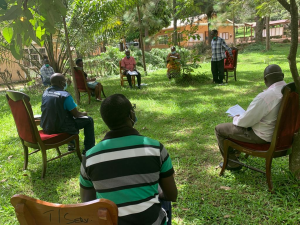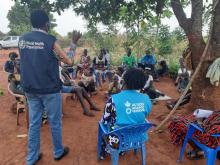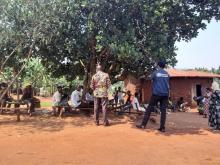When Community Engagement Restored Trust and Raised Public Index of Suspicion for COVID-19
Kampala, 4 September 2020:- When the World Health Organization (WHO), declared the Coronavirus Disease (COVID-19) outbreak a global pandemic, on 11th March 2020, many Ugandans didn’t take it seriously with many saying it was a disease for the affluent, the very high class or for developed countries.
As the disease ravaged the entire world, Ugandans were awakened when the first COVID-19 case in Uganda was confirmed on 24th March 2020. The country was locked down, fear and anxiety set in. Many people practised the prevention and control guidelines announced by the Ministry of Health and abided by the Presidential directives.
As the number of cases increased, many deaths were expected across the country. It didn’t happen and patients most without any known COVID-19 symptoms were discharged from the various hospitals. This diminished the fear and anxiety leading to complacency across communities.
This was the trend of events even in Kagadi District, a rural district of 430,200 people located in southwestern Uganda. People went about their business, oblivious of what was happening elsewhere until 15th July 2020, when a COVID-19 case was detected and confirmed within their midst in Kitoro village in Kitego Parish, Kagadi Town Council.
The confirmed person was a newly recruited foreman working for a road construction company, who travelled from Jinja City in the East and got a job in this company. That was on 15th July 2020 and as the news spread in the district, people once again paid attention mainly out of fear.
The positive person had been around for two (2) weeks and was staying with 24 other casual labourers. They were now contacts and put under quarantine and followed up by contact tracers. Even people who patronize the nearby shops, bars and pork joints were in the same category – close contacts.
But as it normally happens, there was a lot of denial with many close contacts denying ever associating with the positive person. Most of his friends especially housemates and other close associates in the three villages disappeared out of fear and uncertainty which complicated the work of responders and district health authorities.
It was then time for WHO Risk Communication team to get to work. Together with the district health authorities, they engaged community members and individuals in the hotspot villages on COVID-19 emphasizing the consequences if it spreads further due to people’s negative behaviours. They explained the urgency of identifying and listing all contacts to the confirmed person and why they should be in institutional quarantine.
The interactions and community dialogues were many and sustained often ending late in the evenings. It was also a race against time because health workers feared an explosion of cases as there were many close contacts to the confirmed person. The efforts eventually paid off and people voluntarily came out reporting to health authorities and demanding to be quarantined and tested for COVID-19.
In one of the dialogues at Mutunda village, one old woman said in the local dialect, “Tubamanyire kyonka abanyoro bagira, kitandugaho” literally meaning
“We know his close associates including his girlfriends, but the Banyoro have an adage that, “I shouldn’t be the source of information implicating others.”
Others chorused that: “Bagende babakebere bataita ekyaro kyona” meaning “they must go and be tested; lest they spread the virus to the entire village.”
Such was the effectiveness of community engagements that community members took it upon themselves to mobilize all suspected contacts to report to the district health authorities for testing and possible quarantining if they met the criteria.
These community engagements have made the work of contact tracers and surveillance teams much easier especially after sharing the global morbidity and deaths due to COVID. People woke up to the reality that their community of not more than 500 people could easily be wiped out if they remained complacent.
Presently, all the people who had disappeared from the three hot-spot villages out of fear of the unknown are self-reporting often calling the district health office daily to pick their samples for testing. At the time of writing, 71 high-risk contacts had self-reported saving contact tracers the hustle of hunting for them.
“Doctors, thank you for this important education on coronavirus, all the people we know must come for testing or else they will be banished from this village because now we know the facts and we believe you,” said an old man who had listened attentively to the dialogues as he leisurely sipped on a bottle of local beer.
The District Health office together with the WHO Surveillance Consultant for Bunyoro Sub-Region are now overwhelmed by the phone calls from the high-risk contacts who are seeking COVID-19 information and services.
“I have never experienced such a response from suspected high-risk contacts who look for contact tracers to be listed, tested or quarantined in my entire career as an Epidemiologist,” noted Dr. Simon Byaruhanga the WHO Surveillance Consultant. “This approach should become a model and should be replicated elsewhere in the country”, he added as his colleague Mr. Thembo Selevano the District Surveillance Officer nodded in agreement.
Health Promotion Advisor
Tel. : +256 414 335505
Cell: +256 772 507906
Email: sensasib [at] who.int
Public Information Officer
Tel. : +256 313 335569
Cell: +256 786 497073
Email: mwebembezie [at] who.int


